
Mysore, officially Mysuru, is the second-most populous city in the southern Indian state of Karnataka. It is the headquarters of Mysore district and Mysore division. As the traditional seat of the Wadiyar dynasty, the city functioned as the capital of the Kingdom of Mysore for almost six centuries. Known for its heritage structures, palaces, and its culture, Mysore has been called the "City of Palaces", the "Heritage City", and the "Cultural Capital of Karnataka". It is one of the cleanest cities in India according to the Swachh Survekshan.

The Wadiyar dynasty,(Kannada:[ oɖejɐru]) also referred to as the Wadiyars of Mysore, is a late-medieval Indian royal family of former maharajas of Mysore from the Urs clan originally based in Mysore city.
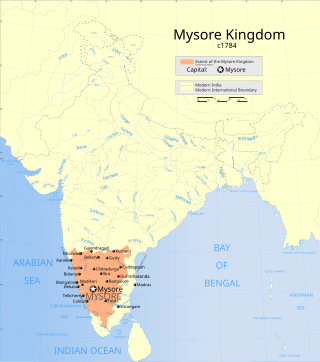
The Kingdom of Mysore was a geopolitical realm in southern India founded in around 1399 in the vicinity of the modern-day city of Mysore and prevailed until 1950. The territorial boundaries and the form of government transmuted substantially throughout the kingdom's lifetime. While originally a feudal vassal under the Vijayanagara Empire, it became a princely state in British India from 1799 to 1947, marked in-between by major political changes.

The Chamundi Hills are located 13 km east of Mysore, Karnataka, India. The name comes from the Chamundeshwari Temple at the peak. The average elevation is 1,060 metres (3,480 ft).

Chamarajendra Wadiyar X was the twenty-third Maharaja of Mysore between 1868 and 1894.

Mysore Palace, also known as Amba Vilas Palace, is a historical palace and a royal residence. It is located in Mysore, Karnataka, India. It used to be the official residence of the Wadiyar dynasty and the seat of the Kingdom of Mysore. The palace is in the centre of Mysore, and faces the Chamundi Hills eastward. Mysore is commonly described as the 'City of the Palaces', and there are seven palaces including this one. However, the Mysore Palace refers specifically to the one within the new fort.

Mysore district, officially Mysuru district, is an administrative district located in the southern part of the state of Karnataka, India. It is the administrative headquarters of Mysore division. Chamarajanagar District was carved out of the original larger Mysore District in the year 1998. The district is bounded by Chamrajanagar district to the southeast, Mandya district to the east and northeast, Kerala state to the south, Kodagu district to the west, and Hassan district to the north.
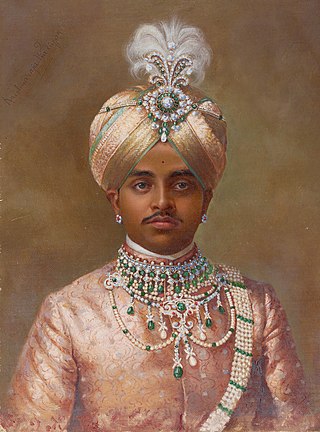
Krishnaraja Wadiyar IV (4 June 1884 – 3 August 1940) was the twenty-fourth Maharaja of Mysore, reigning from 1902 until his death in 1940.

Durbar is a Persian-derived term referring to the noble court of a king or ruler or a formal meeting where the king held all discussions regarding the state. It was used in South Asia for a ruler's court or feudal levy. A durbar may be either a feudal state council for administering the affairs of a princely state, or a purely ceremonial gathering, as was increasingly the case during British rule in India.

Srikanthadattā Narasimharājā Wadiyar was an Indian royal, politician, and fashion designer, who served as Member of Parliament from Mysore. He was the son of Maharaja Jayachamarajendra Wadiyar, the last king of Mysore.
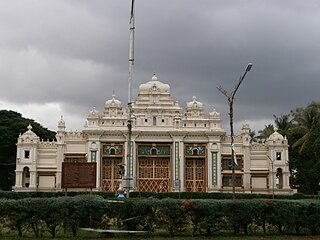
Sri Jayachamarajendra Art Gallery, commonly known by its former name Jaganmohana Palace, is a former royal mansion, arts museum and auditorium, and formerly an alternative royal residence of the ruling maharaja of Mysore, located in Mysore, India, about 200m (600ft) to the west of Mysore Palace. Began in 1856 and completed in 1861, the palace is one of the oldest modern structures in Mysore.

Mysore Dasara is the state festival in the state of Karnataka in India. It is a 10-day festival, starting with nine nights called Navaratri and the last day being Vijayadashami. The festival is observed on the tenth day in the Hindu calendar month of Ashvina, which typically falls in the Gregorian months of September and October.
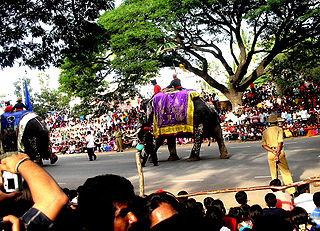
Elephants are an integral part of the Mysore Dasara Festival. The elephants form the core of the Mysore Dasara procession on the Vijayadashami day. The lead elephant carries the Golden Howdah with the Goddess Chamundeshwari in it. The Golden Howdah weighs 750 kilograms and is made of gold.
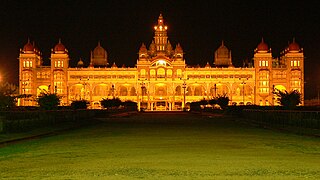
Mysore is a city in the state of Karnataka, India. It is known as the cultural capital of Karnataka. Mysore was the capital of the Wodeyar kings who ruled over the Mysore Kingdom for many centuries. Wodeyars were great patrons of art and music and have contributed significantly to make Mysore a cultural centre. Mysore is well known for its palaces, museums and art galleries and the festivities that take place here during the period of Dasara attract a worldwide audience. Mysore has also lent its name to popular dishes like Mysore Masala Dosa and Mysore Pak. Mysore is also the origin of the popular silk sari known as Mysore silk sari and has also given rise to a popular form of painting known as Mysore painting.

Krishnaraja Wodeyar III was an Indian king who was the twenty-second Maharaja of Mysore. He ruled the kingdom for nearly seventy years, from 30 June 1799 to 27 March 1868, for a good portion of the latter period of which he was merely a nominal ruler. He is known for his contribution and patronage to different arts and music during his reign. He was succeeded by his biological grandson and adopted son, Chamarajendra Wadiyar X.
Urs pronounced as 'Aras', is a surname used by the community associated to the royal family of Mysore Wodeyars based in Mysore in Karnataka, India. The word is derived from Arasu or Arasa which is used to designate royalty or ruler and meant ruler in Kannada. They claim various religious and sectarian affiliations like Shaivism, Vaishnavism, or Jainism according to their clan and lineage. They are directly related to the wodeyars and are related to either distant vijayanagar rulers. The Arasu community is classified as a OBC by the Government of Karnataka.
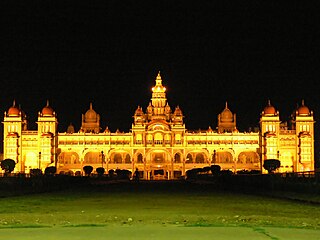
The Mysore Dasara 2013 is the 403rd edition of the annual royal festive gala event, a show of pomp and tradition that is held in the Mysore city in Karnataka, India for 10 days. The festival is called the Navaratri (meaning nine nights or Dussehra or Vijayadashami which conforms to the bright half of the month of Ashvin, from pratipadathithi to navamithithi in the Hindu calendar corresponding to 5 to 13 October during 2013. The festival is also called Nada Habba in Kannada language. The first day of the nine-day festivity started on 5 October with the traditional and religious special puja performed to Goddess Chamundeshwari in the Chamundi Temple on top of the Chamundi Hill, which forms the backdrop to the city; the temple was beautifully decorated with flowers and tourist from Gujarat, Rajasthan and other states enthralled the audience with their bhajan singing. On this occasion, floral tribute wa offered to the goddess by Jnanpith Award winner Chandrashekhara Kambara and festivities will continue for ten days. The ninth day of the festival is a special event called the Mahanavami when the royal sword is worshipped and taken in a procession of elephants, camels and horses. The festival concludes on 14 October on the dashami day with the grand finale of Jambusavari with the idol of Chamundeshawri set in a golden howdah mounted on a richly caparisoned elephant. The procession is taken through the streets of the city and ends in the Banni Mantap where, in the evening, a torch light parade is held. Symbolically, the festival represents the victory of good over evil.
Kāyou Shri Gowrī was the official state anthem of the Kingdom of Mysore, under the rule of the Wadiyar dynasty. The anthem was composed by Basavappa Shastry (1843–1891), the court poet of the Mysore Court under the rule of Maharaja Chamarajendra Wadiyar X, who reigned between 1868 and 1894.

Yaduveer Krishnadatta Chamaraja Wadiyar is an Indian politician and a royal scion from the Wadiyar dynasty, currently serving as a Member of Parliament for Mysore since 2024. The great-grandson of Maharaja Jayachamarajendra Wadiyar, Yaduveer Wadiyar was adopted on 10 December 2013 by Pramoda Devi Wadiyar after the demise of her husband Srikantadatta Wadiyar. He was installed as the titular, "Maharaja of Mysore" in a private ceremony in 2015.

Madhuvana Mysore Royal Cemetery is a site in Mysuru where many members of the Wadiyar royal family were cremated. It is located on Mysuru-Nanjangud road, and is on five acres of land. It is also known as "Khasa Brindavan", or "private garden". The cemetery is in the process of becoming a tourist attraction.


















